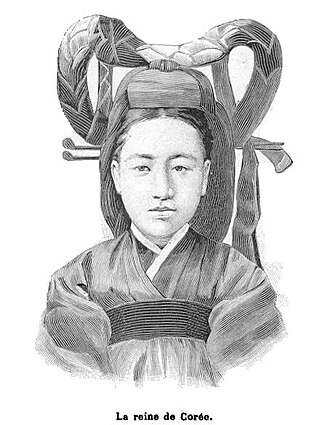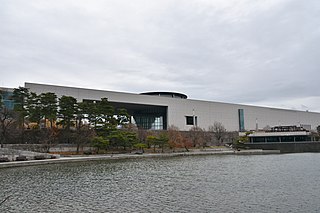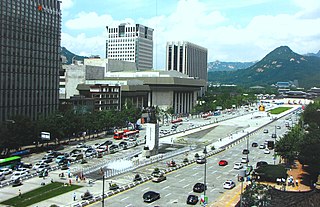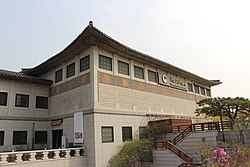
Gojong, personal name Yi Myŏngbok, later Yi Hui, also known as the Gwangmu Emperor, was the penultimate Korean monarch. He ruled Korea for 43 years, from 1864 to 1907, first as the last king of Joseon, and then as the first emperor of the Korean Empire from 1897 until his forced abdication in 1907. His wife, Queen Min, played an active role in politics until her assassination.

Empress Myeongseong was the official wife of Gojong, the 26th king of Joseon and the first emperor of the Korean Empire. During her lifetime, she was known by the name Queen Min. After the founding of the Korean Empire, she was posthumously given the title of Myeongseong, the Great Empress.

Deoksugung (Korean: 덕수궁) also known as Gyeongun-gung, Deoksugung Palace, or Deoksu Palace, is a walled compound of palaces in Seoul that was inhabited by members of Korea's royal family during the Joseon monarchy until the annexation of Korea by Japan in 1910. It is one of the "Five Grand Palaces" built by the kings of the Joseon dynasty and designated as a Historic Site. The buildings are of varying styles, including some of natural cryptomeria wood), painted wood, and stucco. Some buildings were built of stone to replicate western palatial structures.

Namdaemun, officially known as the Sungnyemun, is one of the Eight Gates in the Fortress Wall of Seoul, South Korea. The gate formed the original southern boundary of the city during the Joseon dynasty, although the city has since significantly outgrown this boundary. It is located in Jung-gu between Seoul Station and Seoul Plaza, with the historic 24-hour Namdaemun Market next to the gate.

Gyeongbokgung, also known as Gyeongbokgung Palace, was the main royal palace of the Joseon dynasty. Built in 1395, it is located in northern Seoul, South Korea. The largest of the Five Grand Palaces built by the Joseon dynasty, Gyeongbokgung served as the home of the royal family and the seat of government.

Gyeonghui Palace, literally Palace of Serene Harmony is a palace located in Seoul, South Korea. It was one of the "Five Grand Palaces" built by the Joseon Dynasty.

City Hall Station is a station on Seoul Subway lines 1 and 2. As its name suggests, Seoul City Hall is located right next to the station. Deoksugung, a historic palace of the Joseon dynasty, is on the other side of the boulevard named Taepyeongno.
Yi Hong is a South Korean model and entertainer. She is descendant of Joseon royalty; she is the eldest daughter of Yi Seok by his second wife, Donkgo Jeonghui, and a great-granddaughter of Emperor Gojong of Korea.

Sejongno (Korean: 세종로), also known as Sejong-daero, is a street that runs through Jongno-gu in downtown Seoul. It is named after King Sejong the Great of Joseon. The street is 600 meters in length, but due to its central location it is of great symbolic importance. It points north to Gwanaksan and Bukhansan (Mountains), and the Joseon Dynasty palace, Gyeongbokgung. It is also of historical significance as the location for royal administrative buildings and features statues of the Admiral Yi Sun-sin of Joseon Dynasty and King Sejong the Great of Joseon.

The Kyujanggak, also known as Gyujanggak, was the royal library of the Joseon Dynasty. It was founded in 1776 by order of King Jeongjo of Joseon, at which time it was located on the grounds of Changdeokgung Palace. Today known as Kyujanggak Royal Library, the Kyujanggak Archives are maintained by Kyujanggak Institute for Korean Studies at the Seoul National University, located in Sillim-dong, Gwanak-gu in Seoul. The archive functions as a key repository of Korean historical records and a centre for research and publication of an annual journal titled Kyujanggak.

The National Museum of Korea (Korean: 국립중앙박물관) is the flagship museum of Korean history and art in South Korea. Since its establishment in 1945, the museum has been committed to various studies and research activities in the fields of archaeology, history, and art, continuously developing a variety of exhibitions and education programs.

King Gojong's internal exile to the Russian legation, also called the Agwan Pacheon incident, occurred in 1896 in Korea when King Gojong and his crown prince left the Gyeongbokgung palace to take refuge at the Russian legation in Seoul. The incident resulted in a temporary decline of Japan's influence in Korea and corresponding rise in Russia's influence.

Unhyeongung (Korean: 운현궁), also known as Unhyeongung Royal Residence, is a former Korean royal residence located at 114-10 Unni-dong, Jongno-gu, Seoul, Korea. It was formerly the residence of the Heungseon Daewongun a prince regent of Korea during the Joseon Dynasty in the 19th century, and father of Emperor Gojong. Gojong himself also lived in this residence until age 12 when he assumed the throne. It is currently a museum and is open to the public free of charge.

Gwanghwamun is the main and largest gate of Gyeongbok Palace, in Jongno-gu, Seoul, South Korea. It is located at a three-way intersection at the northern end of Sejongno. As a landmark and symbol of Seoul's long history as the capital city during the Joseon Dynasty, the gate has gone through multiple periods of destruction and disrepair. The most recent large-scale restoration work on the gate was finished and it was opened to the public on August 15, 2010.

Uigwe is the generic name given to a collection of approximately 3,895 books recording in detail the royal rituals and ceremonies of the Joseon dynasty of Korea. There is no generally agreed English translation; some scholars suggest "book of state rites", while the Glossary of Korean Studies from the Korea Foundation suggests "manual of the state event" or "rubrica for a state ceremony." The expression "Royal Protocols" is widely used.

Manwoldae, or Mangwoldae, was the main palace of the Goryeo Dynasty of Korea. It did not have an official name, such as "Gyeongbokgung", because it was an imperial palace like the imperial palaces of China. Located in the Goryeo capital of Kaesong, the palace was burned in 1011, 1126, 1171, 1225, and 1362. The name "Manwoldae" was given to the ruins of the palace during the 14th or 15th century of the Joseon period.

Gwanghwamun Square is a public square on Sejongno, Jongno-gu, Seoul, South Korea. Serving as a public space and at times road for centuries of Korean history, it is also historically significant as the location of royal administrative buildings, known as Yukjo-geori or Street of Six Ministries; and features statues of Admiral Yi Sun-sin of Joseon Dynasty and King Sejong the Great of Joseon.
The following is a timeline of the history of the city of Seoul, South Korea.

The Japanese occupation of Gyeongbokgung Palace or the Gabo Incident occurred on 23 July 1894, during the ceasefire of the Donghak Peasant Revolution and the beginning of the Sino-Japanese War. Imperial Japanese forces led by Japanese Minister Plenipotentiary to Korea Ōtori Keisuke and Ōshima Yoshimasa occupied Gyeongbokgung palace to restore King Gojong's father Heungseon Daewongun and establish a pro-Japanese government under Kim Hong-jip and the Enlightenment Party's administration.

Statue of King Sejong is located at the Sejongno, Gwanghwamun Plaza in central Seoul, South Korea. It is dedicated to the 15th century Korean monarch, Sejong the Great, the fourth king of Joseon dynasty and one of Korea's most famous historical figures. The statue is considered one of Seoul's major landmarks. Unveiled in 2009, it has been called "South Korea's most iconic statue."





















